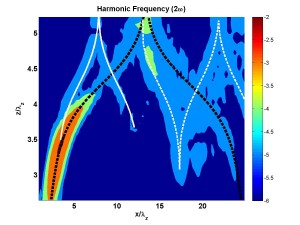 When finite amplitude internal gravity wave beams impact the ocean bottom/surface or variations in the background stratification/shear nonlinear effects emerge. Beyond wave breaking, such effects include the formation of time-averaged mean currents and higher-frequency harmonics. So far, we have investigated such phenomena in two fundamental configurations: the reflection of an internal wave beam off a free-slip surface (a surrogate for the ocean surface on a calm day) and the interaction of such a beam with a model localized ocean pycnocline. Harmonic generation is particularly complex in the latter case, where the spectral multidomain penalty method solver has been invaluable in providing very high-resolution of the pycnocline. For thin pynoclines, whose thickness is 10% of the incident IWB’s horizontal wavelength, harmonics trapped within the pycnocline have maximum amplitude when their frequency and wavenumber match those of the natural pycnocline interfacial wave mode. Results in this case are compared with weakly nonlinear theory for harmonic generation by plane wave refraction. For thicker pycnoclines, whose thickness is equal to the incident IWB’s horizontal wavelength, IWB refraction results in harmonic generation at multiple locations in addition to pycnocline entry, giving rise to complex flow structure inside the pycnocline.
When finite amplitude internal gravity wave beams impact the ocean bottom/surface or variations in the background stratification/shear nonlinear effects emerge. Beyond wave breaking, such effects include the formation of time-averaged mean currents and higher-frequency harmonics. So far, we have investigated such phenomena in two fundamental configurations: the reflection of an internal wave beam off a free-slip surface (a surrogate for the ocean surface on a calm day) and the interaction of such a beam with a model localized ocean pycnocline. Harmonic generation is particularly complex in the latter case, where the spectral multidomain penalty method solver has been invaluable in providing very high-resolution of the pycnocline. For thin pynoclines, whose thickness is 10% of the incident IWB’s horizontal wavelength, harmonics trapped within the pycnocline have maximum amplitude when their frequency and wavenumber match those of the natural pycnocline interfacial wave mode. Results in this case are compared with weakly nonlinear theory for harmonic generation by plane wave refraction. For thicker pycnoclines, whose thickness is equal to the incident IWB’s horizontal wavelength, IWB refraction results in harmonic generation at multiple locations in addition to pycnocline entry, giving rise to complex flow structure inside the pycnocline.
Ongoing work is focused on exploring a number of outstanding questions and also determining the role of not only beam angle and amplitude but also background shear in harmonic formation. We work in close collaboration with Dr. Scott Wunsch at the Applied Physics Laboratory of Johns Hopkins University. The PhD student working on this project is Mr. Anil Aksu.
